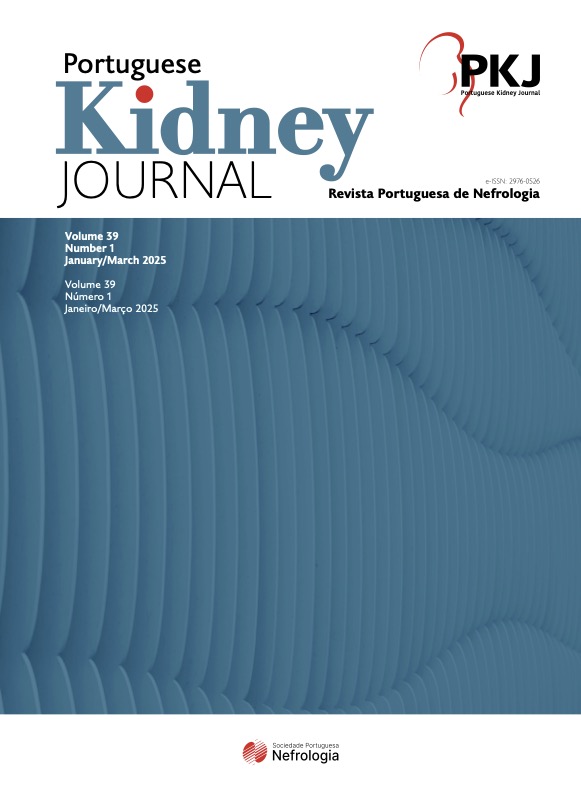C3 Glomerulonephritis: From Diagnosis to Management in a Unique Patient Case
DOI:
https://doi.org/10.71749/pkj.52Keywords:
Complement C3, Glomerulonephritis, Glomerulonephritis, MembranoproliferativeAbstract
C3 glomerulopathies (C3G) are ultra -rare diseases driven by dysregulation of the alternative pathway in the complement system, leading to glomerular C3 deposition and inflammation. C3G includes dense deposit disease (DDD) and C3 glomerulonephritis (C3GN), both associated with progression to end -stage renal disease (ESRD). This report presents a C3GN case, highlighting diagnostic and therapeutic complexities. A 19 -year -old male with recurrent macroscopic hematuria triggered by respiratory infections was initially managed for suspected IgA nephropathy. Follow -up revealed persistent low serum C3 levels, prompting a kidney biopsy that confirmed C3GN with a membranoproliferative pattern and dominant C3 deposits. Genetic testing revealed a C3 mutation and positive anti -Factor H antibodies. Despite treatment with renin -angiotensin -aldosterone system blockade, steroids, and mycophenolate mofetil (MMF), the patient’s proteinuria fluctuated, requiring adjustments in immunosuppressive therapy. C3GN can mimic other glomerulonephritides such as IgA nephropathy and atypical hemolytic uremic syndrome (aHUS). Accurate diagnosis relies on kidney biopsy findings and complement studies; genetic testing can provide critical insights. While available therapies, including immunosuppressants and complement inhibitors, offer partial benefit, C3GN often progresses, underscoring the need for novel, more effective treatments. This case illustrates the diagnostic challenges of C3GN in patients with hypocomplementemia and recurrent hematuria. It emphasizes the importance of targeted research into complement therapies to potentially improve outcomes for C3G.Downloads
References
Fakhouri F, Frémeaux -Bacchi V, Noël LH, Cook HT, Pickering MC. C3 glomerulopathy: a new classification. Nat Rev Nephrol. 2010;6:494 -9. doi: 10.1038/nrneph.2010.85.
Durey MA, Sinha A, Togarsimalemath SK, Bagga A. Anti‑complement-factor H -associated glomerulopathies. Nat Rev Nephrol. 2016;12:563 -78. doi: 10.1038/nrneph.2016.99.
Goodship TH, Cook HT, Fakhouri F, Fervenza FC, Frémeaux‑Bacchi V, Kavanagh D, et al. Atypical hemolytic uremic syndrome and C3 glomerulopathy: conclusions from a “Kidney Disease: Improving Global Outcomes” (KDIGO) Controversies Conference. Kidney Int. 2017;91:539 -51. doi: 10.1016/j.kint.2016.10.005.
Feehaly J, Floege, J, Tonelli, M, Johnson, R. Comprehensive Clinical Nephrology. 6th ed. Amsterdam: Elsevier; 2019.
Rabasco C, Cavero T, Román E, Rojas -Rivera J, Olea T, Espinosa M, et al. Effectiveness of mycophenolate mofetil in C3 glomerulonephritis. Kidney Int. 2015;88:1153 -60. doi: 10.1038/ki.2015.227.
Avasare RS, Canetta PA, Bomback AS, Marasa M, Caliskan Y, Ozluk Y, et al. Mycophenolate Mofetil in Combination with Steroids for Treatment of C3 Glomerulopathy: A Case Series. Clin J Am Soc Nephrol. 2018;13:406 -13. doi: 10.2215/CJN.09080817.
Giaime P, Daniel L, Burtey S. Remission of C3 glomerulopathy with rituximab as only immunosuppressive therapy. Clin Nephrol. 2015;83:57 -60. doi: 10.5414/CN107945.
Servais A, Frémeaux -Bacchi V, Lequintrec M, Salomon R, Blouin J, Knebelmann B, et al. Primary glomerulonephritis with isolated C3 deposits: a new entity which shares common genetic risk factors with haemolytic uraemic syndrome. J Med Genet. 2007;44:193 -9. doi: 10.1136/jmg.2006.045328.
Pickering MC, D’Agati VD, Nester CM, Smith RJ, Haas M, Appel GB, et al. C3 glomerulopathy: consensus report. Kidney Int. 2013;84:1079 -89. doi: 10.1038/ki.2013.377.
Bomback AS, Appel GB. Pathogenesis of the C3 glomerulopathies and reclassification of MPGN. Nat Rev Nephrol. 2012;8:634 -42. doi: 10.1038/nrneph.2012.213.
Medjeral -Thomas NR, O’Shaughnessy MM, O’Regan JA, Traynor C, Flanagan M, Wong L, et al. C3 glomerulopathy: clinicopathologic features and predictors of outcome. Clin J Am Soc Nephrol. 2014;9:46 -53. doi: 10.2215/CJN.04700513.
Martínez -Barricarte R, Heurich M, Valdes -Cañedo F, Vazquez -Martul E, Torreira E, Montes T, et al. Human C3 mutation reveals a mechanism of dense deposit disease pathogenesis and provides insights into complement activation and regulation. J Clin Invest. 2010;120:3702 -12. doi: 10.1172/JCI43343.
Zhang Y, Meyer NC, Wang K, Nishimura C, Frees K, Jones M, et al. Causes of alternative pathway dysregulation in dense deposit disease. Clin J Am Soc Nephrol. 2012;7:265 -74. doi: 10.2215/CJN.07900811.
Smith RJ, Harris CL, Pickering MC. Dense deposit disease. Mol Immunol. 2011;48:1604 -10. doi: 10.1016/j.molimm.2011.04.005.
Le Quintrec M, Lapeyraque AL, Lionet A, Sellier -Leclerc AL, Delmas Y, Baudouin V, et al. Patterns of Clinical Response to Eculizumab in Patients With C3 Glomerulopathy. Am J Kidney Dis. 2018;72:84 -92. doi: 10.1053/j.ajkd.2017.11.019.
Bomback AS, Smith RJ, Barile GR, Zhang Y, Heher EC, Herlitz L, et al. Eculizumab for dense deposit disease and C3 glomerulonephritis. Clin J Am Soc Nephrol. 2012;7:748 -56. doi: 10.2215/CJN.12901211.
Nester CM, Smith RJ. Treatment options for C3 glomerulopathy. Curr Opin Nephrol Hypertens. 2013;22:231 -7. doi: 10.1097/MNH.0b013e32835da24c.
Wong E, Nester C, Cavero T, Karras A, Le Quintrec M, Light‑stone L, et al. Efficacy and Safety of Iptacopan in Patients With C3 Glomerulopathy. Kidney Int Rep. 2023;8:275464. doi: 10.1016/j.ekir.2023.09.017.
Downloads
Published
Issue
Section
License
Copyright (c) 2025 Pedro Castro, Nuno Oliveira, Rui Alves (Author)

This work is licensed under a Creative Commons Attribution-NonCommercial 4.0 International License.




